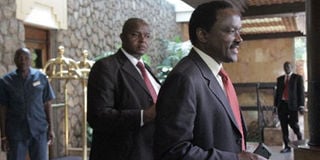Mudavadi, Kalonzo begin alliance talks

Vice President Kalonzo Musyoka (right) leaves Serena Hotel after a closed door meeting with Deputy Prime Minister Musalia Mudavadi on November 6, 2012. Photo/EMMA NZIOKA
What you need to know:
- Mudavadi, Kalonzo meet on coalition talks, nothing concrete
Deputy Prime Minister Musalia Mudavadi on Tuesday morning met Vice-President Kalonzo Musyoka at the Serena Hotel in Nairobi for talks as politicians continue to seek alliance ahead of next year’s elections. Read (Mudavadi open to pre-polls alliances)
The two leaders met for close to three hours and were accompanied by Yatta MP Charles Kilonzo and his Ikolomani counterpart Dr Boni Khalwale.
The two MPs said that the talks were not as fruitful as they expected but added that the two presidential aspirants will continue to meet.
“The VP and the DPM have been in government for a very long time and it has been disturbing to us that they have not sat down together. We decided to invite them for tea but they were not able to open up to anything concrete,” Dr Khalwale said.
Mr Kilonzo said that it was paramount for leaders who share the same ideals to seek to work together.
He added that they were expecting such meetings between the two and even other leaders in the coming days.
“This is the time for taking tea and that is what was happening here today (Tuesday). You can expect more meetings in the coming days,” Mr Kilonzo said.
Mr Musyoka has been associated with the G7 Alliance which brings together Deputy Prime Minister Uhuru Kenyatta, Justice Minister Eugene Wamalwa and Eldoret North MP William Ruto.
The three have however been working together for a coalition that appears to leave out the VP.
The VP has however insisted that he is firmly in G7 despite talk that Mr Kenyatta and Mr Ruto were firming up their deal for a joint ticket.
The dilemma within G7 is how to settle on the presidential candidate and running-mate without occasioning fallouts within the group.
The Nation has learnt that there is a suggestion to have all the presidential aspirants participate in a joint nomination process but whoever comes in second does not automatically become the running-mate.
After the first round, there is a suggestion that the losers then go through a second nomination process to identify the running-mate.
Other than this, there is also a suggestion that the team uses a mathematical analysis of the perceived support of each of the aspirants prepared by their technocrats to project the best winning combination for the first round.
The analyses based on the 2007 presidential votes where Mr Kenyatta is apportioned what President Kibaki got while Mr Ruto is given those that were taken by Prime Minister Raila Odinga in Rift Valley.
The technocrats have classified the Counties under Mr Odinga and Mr Mudavadi’s control as the “hostile ones”.
Where President Kibaki slightly beat Mr Odinga and vice versa in 15 Counties are considered as the swing votes.
Among the other issues that have been on the table is how to run joint presidential nominations while allowing the parties to field candidates in their strongholds.
However, the main point of contention is how they will field candidate in cosmopolitan areas such as Nairobi and Mombasa.
Initially, there were considerations that the parties in the Kenyatta - Ruto coalition adopt a zoning structure that would see them field candidates in their stronghold.
However, this position is said to have been shelved and the technical teams are only working on joint nominations for the presidency and opening up rivalry for the other positions.




